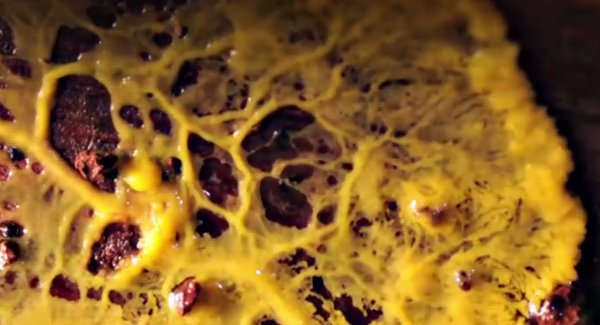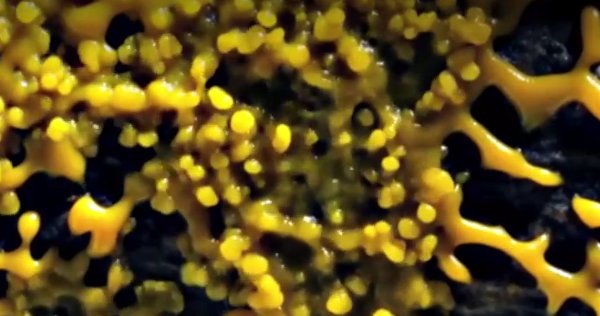
|
The Blob, whose scientific name of which is Physarum polycephalum and the common name "amoebozar", is a living organism that typically is about 10 centimeters wide but is composed of... a single cell.
The Blob is not an animal, nor a plant, nor a fungus. It is a fourth order of the living on Earth.
The Blob has no brain or nervous system. Yet it has been discovered that he is not only able to learn from its experiences, but also to share what it has learned to other Blobs by merging with them permanently or temporarily.
This was demonstrated for the first time in April 2016 [1], by a CNRS (French National Center for Scientific Research) team, at the University of Toulouse III Paul Sabatier, led by Audrey Dussutour. This was the subject of a second scientific publication in December 2016 [2].
In the abstract of the second scientific publications of the discovery, the authors say:
Cell fusion is a fundamental phenomenon observed in all eukaryotes. Cells can exchange resources such as molecules or organelles during fusion. In this paper, we ask whether a cell can also transfer an adaptive response to a fusion partner. We addressed this question in the unicellular slime mould Physarum polycephalum, in which cell-cell fusion is extremely common. Slime moulds are capable of habituation, a simple form of learning, when repeatedly exposed to an innocuous repellent, despite lacking neurons and comprising only a single cell. In this paper, we present a set of experiments demonstrating that slime moulds habituated to a repellent can transfer this adaptive response by cell fusion to individuals that have never encountered the repellent. In addition, we show that a slime mould resulting from the fusion of a minority of habituated slime moulds and a majority of unhabituated ones still shows an adaptive response to the repellent. Finally, we further reveal that fusion must last a certain time to ensure an effective transfer of the behavioural adaptation between slime moulds. Our results provide strong experimental evidence that slime moulds exhibit transfer of learned behaviour during cell fusion and raise the possibility that similar phenomena may occur in other cell-cell fusion systems.
During a nine-day experiment, scientists confronted different groups of this protist with bitter but harmless substances; which they had to cross in order to reach a source of food. One group was confronted with a "bridge" impregnated with quinine, another with a caffeine bridge, while a control group was simply passing over an unimpregnated bridge. At first they were reluctant to cross the bitter substances, but the protists learned as the days went that they were harmless and crossed them more and more quickly, behaving after six days in the same way as the control group. The cell has thus learned to no longer fear a harmless substance after having been confronted to it several times, a phenomenon that scientists call habituation. At the end of two days without contact with the bitter substance, the protist revovered its initial mistrust behavior. On the other hand, a protist who was accustomed to caffeine shows a behavior of no confidence in quinine, and vice versa. Habituation is therefore very specific to a given substance.
Habituation is a rudimentary form of learning that has been characterized in Aplysia (an invertebrate also called sea hare). This form of learning exists in all animals, but has never yet been found in an organism devoid of nervous system. This discovery in a protist, a distant cousin of plants, mushrooms and animals, that appeared on Earth about 500 million years before man, makes it possible to better understand the origins of learning, which precedes by far the origin of the nervous systems. It also opens up the possibility of looking for types of learning in other very simple organisms such as viruses or bacteria.

|

|
The Blob is a single cell, but contains thousands of nuclei. While its size is generally about ten centimeters, by simply feedinf it, it can reach several square meters of surface. It moves in its environment at a speed of up to five centimeters per hour.
It is more primitive than the three well-known orders of animals, plants and fungi, but shares characteristics with these three kingdoms. It breeds like a mushroom, it eats like an animal and it has the pigments of plants. It is bright yellow colored, flat, and traversed by a venous system that allows to distribute all the resources inside the cell. It has no definite shape, it has pseudopods, small growths that go in all directions.
It has been known a very long time ago, it has nearly a thousand close species. It can be found microscopically or macroscopically in undergrowth, forests, it hates light and is difficult to see because it is easily confused with a fungus or lichen. It is very sticky and needs a lot of moisture.
It exists for at least 500 million years, at most a billion years. It builds networks, eats mushrooms, and in laboratory, loves oat flake. It has are 720 different sexes.
Its lifetime is unknown, but a Blob in a laboratory has kept alive for over 60 years. A cut piece of a Blob continues to live and develop, suggesting potential immortality.
In an interview published in the French newspaper La Dépêche on December 24, 2016, Audray Dussutour stated:
"What we already knew was that it knows how to get out of a labyrinth, that it connects its venous network on different optimal sources of food. A network much better developed than the Japanese railway network, according to researchers. It was checked whether it could solve nutritional problems, which all living organisms are confronted with. We realized it was doing better than we did. It is unicellular, without brain, and one observes that it can in fact learn. It informs us about the origin of learning processes and the great evolutionary transitions. It shows that a cell is capable of learning by itself. In the brain, memory is a network of neurons, we always believed that. Now, memory may be contained in the cell. On last April, it was taught to ignore the salt, we did it with 2000 "blobs" and they were fused with ingorant "blobs" (who had never met salt). We observe that during this fusion with experienced "blobs", all behave like experienced blobs. So there is a real transfer of learning from one blob to the other."
She explaineds that as a cinephile, she called this organism "The Blob" because of the 1958 movie of the same name with Steve McQueen, who told how a giant sticky alien that doubled in size each day spread terror in the small town of Downingtown, Pennsylvania.